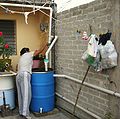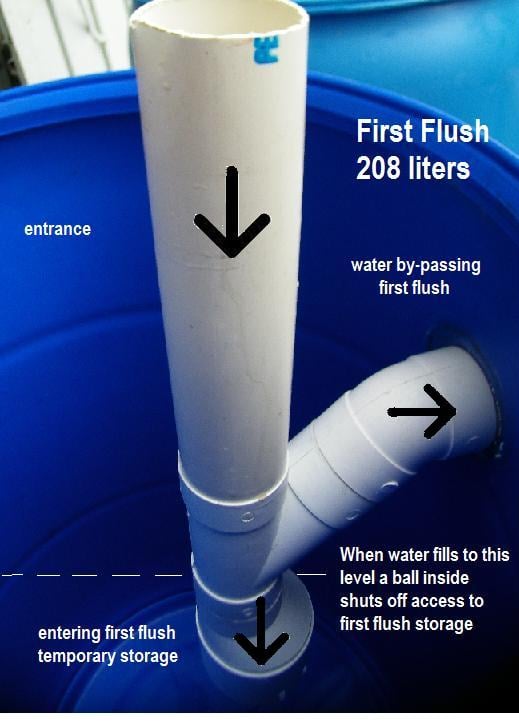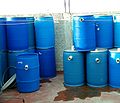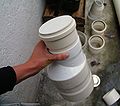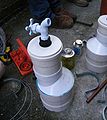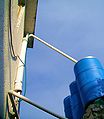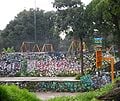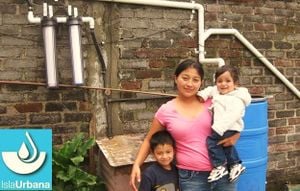
Isla Urbana is a nonprofit working in Mexico City as well as in other areas of Mexico to improve water quality and water accessibility to people who have no reliable access to clean water. They coordinate efforts with different communities to build local capacity and local jobs for designing and building rainwater catchment systems around Mexico. They provide design assistance, training to plumbers, and provide parts for the rainwater harvesting systems. This is one project in a series of water quality and community service projects at Isla Urbana.
Water access is often unreliable in Mexico City and many poor or migrant or immigrant communities are the last to receive any service in terms of access to municipal water. Garafon trucks full of clean drinking water drive around the streets selling water to whoever can afford it. Municipal water is often turned off for 3-4 months at a time a year. Piping with clean municipal water may also get contaminated in some houses with grey water based on plumbing problems. Isla Urbana has dedicated themselves to increasing access to fresh water supplies by just collecting what all ready falls from the sky. This solution not only gives people access to fresh water, it also helps reduce flood flooding that causes further problems for stormwater and wastewater treatment systems in Mexico City.
-
thumb]]
-
-
-
Children writing about nature, rain, and resources with IslaUrbana]]
-
Family helped out by Isla Urbana's rainwater harvesting installation
-
-
System with first flush on left and filters on right
System design

Different Installations and Designs
-
1.a First rain enters 140 L first flush the following rain goes into the cistern then when needed it is pumped through the filters and to the roof top tank for water pressure
-
1.b Two roofs with two separate first flushes share a cistern
-
1.c One pipe goes from the roof to the 250 L first flush then to the cistern for domestic use and another parallel pipe goes to a separate tank for the garden.
Components of the Rainwater Catchment System
Roof top, Gutters, Screen, and Piping
-
The gutters are formed from bricks lining the perimeter of the cement roof.
-
Piping from the gutters is attached to the side of the house by encasing it between two bricks and cement
-
Piping then runs down to the first flush
-
Before water enters the first flush it goes through a screen to remove leaf litter, which could clog up piping or reduce volume space in first flush.
Rooftop Collection
For more info on Collection Calculations.
Gutters
- Many houses in Mexico do not have gutters, so you can be very creative in creating new gutter systems, however this can also be the step that takes the longest if you do not design ahead of time comparing material costs and availability.
- Brick or Cement Gutters: This is a simple design for homes with cement roofs. Bricks are lined around the perimeter of the roof stopping water from leaving over the edges. Water then rolls to the lowest edge of the roof, where pipes to the gutters are inserted between two bricks and cemented in place for easy collection.
Screen
- A screen where the gutter empties into the pipe helps prevent clogging and more maintenance issues. If any organic leaf litter did end up making it to the tank the rotting material could also pose health issues.
- However, a screen is not necessary if your canals already are designed with a protective covering that prevents leaf litter from getting into the tubing. If one is already using PVC for the canals a simple alteration in the design could include rather then cutting the top half of the canal off, only cutting a small slit in the canal that only allows water into the canal.
Pipe
For more info on Pipe sizing calculations.
First Flushes
First Flushes, also called roof washers, remove toxins from your roof by flushing out the first 55 to 208 liters from any rain.
These toxins usually include bird droppings, air pollution, and chimney smoke particulates.
In Mexico City what Isla Urbana is especially worried about is air pollution accumulation, which include emission sources from: smokestacks, landfills, fires, car exhaust, factory equipment leaking, and commercial products, like paints and chemical household cleaners.[1]
Since many of the roofs are flat cement roofs the particulates accumulate more then those areas with slanting roofs and thus many of Isla Urbana's systems are designed with a much larger 208 liter first flush.
Recommended Ratios for First Flush
- 1 liter in a first flush per 1 square meter of roof can remove 50% of contaminants [verification needed]
- 2 liters in first flush per 1 square meter of roof can remove 75% of contaminants
the later is what Isla Urbana strives to make for those houses with flat roofs in Mexico City
For more First Flush Calculations go to First Flush Calculations.
2 Different Designs @ Isla Urbana
208 LITER FIRST FLUSH
This design is made out of a 55 gallon or 208 liter bucket. PVC piping is inserted inside with an opening to the bucket.Inside the piping is a small plastic ball, when the water level rises it raises the ball. When the water rises to the level wanted for removing the needed amount of water the ball shuts off the pipe that allows water to enter the bucket. Instead the rest of this water moves through the PVC pipe in and out of the first flush without being added to the water flushed out of the system. This design removes up to 75% of contaminants for a system with a roof area of 104 meters or less.
-
208 liter first flush for rain catchment
-
Metal popping seal with PVC entering at top and exiting on side
-
Inside of first flush
-
Finished first flush with filter and inlet screen inside for delivery to homes
140 LITER FIRST FLUSH
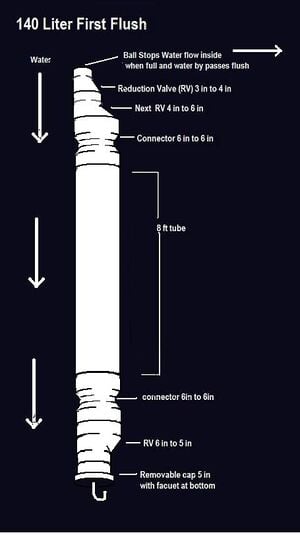
This design uses PVC tubing as a temporary storage for the first waters of any rain. The temporary storage is a 6 inch diameter and 8 foot tall PVC pipe. Connectors on top help connect the different sized tubes with 3 transition connectors between the common 3 inch diameter piping and the 6 inch temporary storage tube. At the bottom are another two connectors to a removable cap with a hole drilled in the bottom and a faucet attached so that the pipe can be drained manually after a rain. Other designs include just a small hole that is self draining, but these consequently are continually draining and thus the first flush is continually being refilled even after you've flushed out the first few liters of rain. This loss may or may not add up depending on your tank size and the amount of rain fall in a year. Isla Urbana's design requires manual draining, but it only looses the amount of rain it is sized to and the bottom has a removable cap for easier maintenance in removing any sediment buildup.
-
140 liter First flush bottom step 1. scratch and glue connections of all PVC fittings for bottom
-
Step 2 Drill hole in bottom of first flush
-
Making the first flush
-
Finished bottom of 140 liter first flush
-
finished bottom attached to 6 inch by 8 ft PVC piping acting as the temporary storage of the first flush
-
Finished top to first flush with smaller 3 inch fitting at top connecting to the piping that goes to the gutters
-
140 liter first flush on left of PVC pipe and piping passing to tanks
Cistern

-
High Density Polyethylene HDPE Cistern
-
Rotoplas Tank
Underground Cement lined Cisterns
Usually in Mexico these cisterns are all ready in place in many homes who all ready have some access to the municipal water supply. This access may not be all year long or may have poor water quality, thus rain catchment is a good addition that can utilize the existing cistern in place. These cisterns change volume based on the desired size and depth.
High Density Polyethylene HDPE Cistern
This flexible plastic material can be rolled up and easily travel far distances out to rural communities.
It has high resistance to being torn and stretched, making it good for holding in water.
However it does not have a high puncture resistance, thus a knife stabbed into the material could puncture it.
Rotoplas Tanks
This plastic is very resistant to punctures, tearing, and stretching.
However it is not flexible or compactable and transportation of large tanks above 10,000 liters are hard to move large distances.
- For more information on the rates of tank diameter and size to water holding capacity look at Rainwater catchment at Pedregal
Filters

The demands of filtering rain water are different from those of filtering municipal and river system water supplies that may include endocrine disrupting chemicals, pharmaceuticals, agrochemicals and industrial chemicals, and unprocessed human and animal waste water. Rain water on the other hand usually only needs to have: any pollutants in the sky, dust particles, tar on roofs, and any chemical products that may be used for anything upon/within the catchment surface filtered out.
When choosing filters Look for:
- Flow rate through filter and effect on ending water pressure
- Which suspended solids and contaminants can it remove
- Sequence of different filters based on which solids and contaminants are removed
- Cost
Filter Sequence:
Not all of the following filters are used in every system. The majority of systems sole have the pleated sediment filter followed by the activated carbon filter. These two filters alone can help purify the water enough for domestic uses.
1.Pleated Sediment Filter
Removes sediments. The pleats in this filter provide increased surface area for increased removal of sediments. The pleats also allow a small increase in flow rate, however an increase in the flow rate can also somewhat decrease sediment removal. These filters are packaged as cartridges that can be removed and manually cleaned with direct spray into the pleats of the filter.
Cost ranges from $8-30.
2.100 Micron Sediment Filter
Removes sediment as small as 100 micrometers. Often made of wound polypropylene.
3.Activated Carbon Filter
Activated carbon is processed charcoal that it is increasingly porous and has a larger surface area for adsorption and other chemical reactions. 1 gram of activated carbon has a surface area in excess of 500 m2. Contaminants in the water are attracted to the carbon and cohese to the surface of the carbon in thin layers. This means the activated carbon filters can be cleaned of these contaminants and reused.
Activated Carbon can remove: copper, chlorine, carbohydrates and other dissolved organic materials. Granular activated carbon has also been found to be highly effective at removing pharmaceuticals and endocrine disrupters. However, its also been demonstrated that compounds with greater hydrophilicity pass through activated carbon faster than hydrophobic compounds.
If using a reverse osmosis filter placing this Activated Carbon Filter helps preserve the reverse osmosis membrane by removing organic materials and chlorine that degrade the membrane.
Cost ranges from $30-80.
4.Reverse Osmosis Filter
- Is great at filtering large molecules and ions from solutions by applying pressure on one side of a selectively permeable membrane. This process is the opposite of natural osmosis where water (or solvent) passes from the area of high solute concentration to the area of low solute concentration. The pure water (or solvent) moves to equalize the solute on both sides generating pressure called the osmotic pressure. Applying pressure on one side reverses this process and is thus called reverse osmosis.
- Reverse osmosis is a common filtering application used in purification of seawater into drinking water.
- Efficiency of filtration is dependent on the concentration of the solute, the pressure, and the rate of water.
5.20" Cellulose Filter
Removes dust from charcoal as well as many trace elements including: lead, mercury, arsenic, aluminum, iron, fluorine, nitrogen, potassium, chlorine, sulfur, and others. Usually made of high density cotton.
6.Silver Ion Filter
- Silver ions have antibacterial properties by inhibiting both the growth of bacterial organisms and their signal transduction.[2]
- two plates of silver are inserted into water piping and charges are alternated across the two plates creating arcs where silver ions jump off into the water.
Storage Tank on Roof for Water Pressure

-
Cement storage tank
-
Plastic rotoplas tank
-
These roof top tanks are usually already found at houses for supplying water pressure to the house for grid water
-
Isla Urbana optimizes on these tanks all ready being in homes and hooks up the raincatchment to these tanks
Many houses in Mexico all ready have storage tanks on their roof so that water from the municipal supply can be pumped to the roof and have gravity fed water pressure. Though there is some pumping involved in getting the water to the roof from the cistern below it requires much less energy when using gravity to provide the water pressure for a shower or sink. Isla Urbana's design utilizes the components all ready available in many homes including these roof top storage tanks for providing the water pressure. A separate storage is still needed beyond these small rooftop tanks because these are generally much smaller, however houses also usually all ready have a separate underground cistern where they store municipal water. Isla Urbana taps into this preexisting design to reduce costs and provide a system where some of the components are familiar for families and thus more likely to be maintained.
End Use
End uses for these systems include:
1.Domestic uses:
- washing clothes
- taking showers
- cleaning dishes
2.Gardening:
- irrigation
-
Drinking filtered rainwater
-
Using rainwater to wash the dishes
-
Clothes washed with rainwater
-
Lastly, watering the garden with rainwater
Current Opportunities
- Isla Urbana made it to the top ten in the BBC's World Challenge for projects showing enterprise and innovation at a grass roots level to help make a difference and better the world.
Vote from September 27th - Nov 12th for Isla Urbana
Winners get 25,000 for future projects and Isla Urbana plans to use this money for improving and greening community spaces on the out skirts of Mexico City, in areas that were previously shanty towns.
-
Isla Urbana wants to improve park spaces with an award from BBC's World Challenge
-
-
Park space in the Community of Cultura Maya
- An Internship Program with Isla Urbana is also currently being developed that might include urban gardening and community outreach and green space creation. For more info contact Isla Urbana.
References
- ↑ Environmental Protection Agency, US EPA. Air Contamination. http://web.archive.org/web/20140929213350/http://www.epa.gov:80/superfund/students/wastsite/airpolut.htm
- ↑ Shrivastava,Siddhartha; Bera,Tanmay; Roy,Arnab; Singh,Gajendra; Ramachandrarao, P; and Dash, Debabrata. Characterization of enhanced antibacterial effects of novel silver nanoparticles. http://iopscience.iop.org/0957-4484/18/22/225103
![thumb]]](/w/images/thumb/9/91/Logo-Isla-urbana-facebook-2dark.jpg/120px-Logo-Isla-urbana-facebook-2dark.jpg)


![Children writing about nature, rain, and resources with IslaUrbana]]](/w/images/thumb/f/f9/SDC11107.JPG/120px-SDC11107.JPG)






